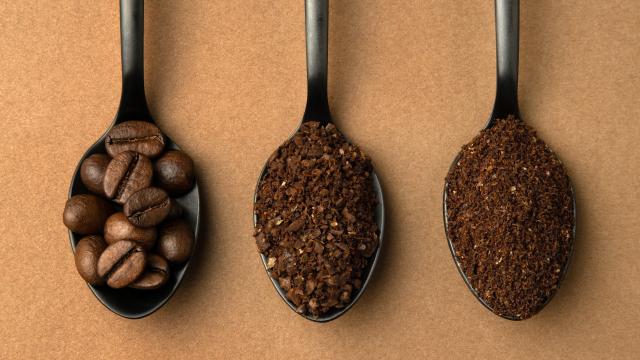Every cup of coffee, good or bad, starts with a bean being ground. And whether it was done by an industrial machine before being packaged and shipped to a store, or you did it yourself with a hand-grinder before brewing up a batch of French press, grinding is an important step in your journey to a satisfying sip.
Like everything else coffee, grinding is an art as much as it is a food science, but you don’t need to be an expert to begin experimenting on your own. Here’s a breakdown of the basics, in the form of four tips to keep in mind.
The grind size truly matters
When you’re making coffee, matching the grind size with your brewing method of choice matters quite a lot. Generally speaking, grind size for a home espresso machine will be quite fine, almost like a powder, in order to adequately flavour the coffee as the machine pushes water through it quickly. If you’re making a French press, the grind size will be quite coarse, because you’ll be steeping the coffee in water for several minutes. (The video above will help you find the right grind size for your coffee brewing method.)
If you buy your coffee pre-ground, pay attention to grind size. Pre-ground coffee sold in grocery stores in the U.S. is usually ground to a consistency suitable for a drip-style coffee maker that uses a filter. If you use one of those machines, you’re fine. If you’re making a French press, using a Moka Pot, or if you have a small home espresso machine, this catch-all grind will be less than ideal. Instead, provided your store offers it,you’re better off grinding the beans to your desired consistency there.
Keep your beans fresher for longer
Once you have figured out the grind size, the next step is the act of storing coffee so that it stays fresh for as long as possible, as it’s likely your bag of beans (ground or not) is going to sit on a shelf for a few weeks before you use it all up.
While in your kitchen, the coffee beans are interacting with the environment, and the process of oxidation (interaction with oxygen in the air) marches on. Over time, this makes the coffee stale, or even rancid. A coffee that’s left out for too long loses its fresh aroma and will develop a tanny aftertaste that drinkers of black coffee especially won’t appreciate.
One option is to buy freshly roasted ground coffee and use it within two weeks, but that’s not always feasible. You can stretch out its lifespan by storing it in airtight containers. Transferring your coffee from the bag into a sealable plastic or glass containers and keep it away from direct sunlight will extend the life of your coffee (especially pre-ground coffee) by days or weeks.
Coffee beans release carbon dioxide while just sitting there. This process is called “degassing.” Most of that gas is released in a couple of hours after roasting, so as long as you open the airtight jar every day (or every couple of days), you don’t have to worry about a buildup of CO2 making your coffee taste worse.
Go with a burr grinder over a blade
Grinding coffee at home is a quality-of-life upgrade, and will have an immediate effect on how your coffee tastes. Think of it like the difference between eating canned beans versus fresh veggies from the farmers’ market.
There are generally two types of home coffee grinders: blade grinders and burr grinders.
Blade grinders work like a typical kitchen blender, and have rotating blades that cut the coffee into fine particles. Blade grinders are cheap, easily available, and get the job done quickly. The downside: an uneven grind (while this doesn’t matter much when you’re making a smoothie in a blender, coffee is a lot more finicky). You have to run the grinder for longer to ensure all of the beans are ground — but the longer you run it, the finer (some of) the coffee will get. This makes it virtually impossible to get the same grind size every time you make coffee.
Burr grinders, on the other hand, use a revolving set of burr instead of a blade, gently crushing the coffee instead of cutting it. They are made out of metal and are incredibly resilient — and consistent. Burr grinders include as many as several dozen different settings allowing you to precisely control the grind size with consistency, meaning your French press won’t taste widely different from day to day.
A entry-level hand grinder is a low-cost way to get started
Want to start making fresh coffee ever day? A budget hand grinder will go a long way. You can get a cheap ceramic burr grinder for as little as $US13 ($18), or for around $US50 ($69), a more professional-grade model like Timemore’s C2 hand grinder. It has a steel burr, and looks and works like grinders that cost four times as much.
Hand-grinding will give you consistent grinds, whether you’re making an espresso or a pour-over, and can still work quickly; the C2 can grind 20 grams of coffee in under 45 seconds.
If the idea of grinding coffee by hand doesn’t excite you, there is a wide range of electric burr grinders. Our favourite is the Baratza Encore ($US169 ($235)), but cheaper options are available. Any of them will make a better cup than if you stick with pre-ground beans.

Leave a Reply
You must be logged in to post a comment.